Shaping Vancouver 2019: What's the use of heritage?
Conversation 3: Is Heritage Relevant?In this third installment of Shaping Vancouver, we examined the disruption taking place in heritage and the challenges it faces in remaining relevant, especially in the context of improving our city.

Moderator
Bill Yuen – Executive Director of Heritage Vancouver
Panelists
Angie Bain – Researcher with the Union of BC Indian Chiefs, Director with Heritage BC
Paul Gravett – Executive Director, Heritage BC
Aneesha Grewal – Vice-Chair Punjabi Market Regeneration Collective
Robert Lemon – Architect, Former Senior Heritage Planner for the City of Vancouver
View a recording of the talk above. The video is part of a playlist – there are eight parts in total. Clicking on the play button on the YouTube video above will start the playlist, which will auto-play the entire talk’s playlist. Navigate through the eight parts using the sidebar of the YouTube players.
There is a significant disconnect between heritage as a discipline and heritage as practiced locally on the ground. As a discipline, heritage has changed considerably in recent decades. It has moved beyond traditional boundaries and intersected with issues such as equity, social values, climate change, housing, and community planning.
Provincially, nationally and internationally, experts and experienced professionals consistently identify several core themes and explore their impact on practice:
- There is a growing interest in heritage as a living system of relationships between people and place;
- There is an understood need for greater attention to cultural diversity and how different cultural groups value heritage (e.g. First Nations, women, LGBTQ2);
- Classical heritage concepts around building preservation alone do not address contemporary societal needs and issues; resolution of these needs requires broader and more interdisciplinary approaches
Locally, the heritage field in general is just starting to consider these broader ideas.
Competing meanings have been attached to heritage, and there are opposing views on the evolution of the discipline expressed. Some feel heritage has broadened too far while others feel strongly that heritage needs to continually re-examine its concepts in order to respond to current needs. This comes at a time when there is increasing questioning of the usefulness of heritage due to its traditional focus on preservation.
In this third installment of Shaping Vancouver, we will examine the disruption taking place in heritage and the challenges it faces in remaining relevant.
Panelists
Angie Bain – Angie Bain is Nlaka’pamux from Lower Nicola, BC. She is a researcher with the Union of BC Indian Chiefs and also works on Traditional Use studies, crown land referrals, community planning and cultural heritage projects for the Lower Nicola Indian Band. Angie a Research Associate, Volume Editor and member of the Indigenous Advisory Council on the Franz Boas Paper Project. Together with Karen Aird and Gretchen Fox, Angie prepared the recent policy paper Recognizing and Including Indigenous Cultural Heritage in B.C.
Paul Gravett – Paul Gravett has extensive experience working with not-for-profit organizations as an executive director, interim manager, consultant, and board chair. As a consultant, Paul has worked with organizations in the arts, heritage and wellness sectors, focusing on building viable businesses through values-driven strategies. Paul began work with Heritage BC as interim executive director in 2016, later taking the position on a permanent basis. His work has concentrated on expanding the role of the organization and the inclusivity of its work. Paul led the province-wide State of Heritage project that involved 25 meetings and 500 participants.
Aneesha Grewal – Aneesha values land back and eco-community care. Aneesha is a second-generation Punjabi settler. Their research interests include identity formation, cultural hybridity and settler colonialism; rooted in decolonial theorizations of oppression and its intersections. Aneesha hopes to aid in the decentering and denormalization of capitalism and the white cis-hetero-patriarchy.
Robert Lemon – Robert G. Lemon Architect AIBC has had four decades of experience with heritage conservation in British Columbia. His firm Robert Lemon Architect Inc. has completed award-winning conservation work on Vancouver landmarks including Hotel Georgia, Coastal Church, Shannon Estate, Jameson House and Downtown YMCA. From 1991 to 1996 Lemon was the Senior Heritage Planner for the City of Vancouver where he oversaw the introduction of heritage legislation and developed the city’s transfer of density policy, Recent Landmarks program and Heritage Interiors initiatives. Lemon wrote the provincial Rehabilitation Standards and Guidelines and was co-author of the heritage provisions of the BC Building Code. He was a member of the working party for the federal Standards and Guidelines for the Conservation of Historic Places in Canada. Lemon studied conservation at ICCROM (Rome) and completed his MA in Conservation at University of York (UK). He established local chapters of APT and DOCOMOMO and has given papers on conservation topics in Banff, Trent University, Ottawa, Chicago, Miami, Stockholm and Slovakia. He is the past chair of the Vancouver Heritage Foundation.
Moderated panel discussion
What is the state of heritage in relation to us? (13:06)
Paul Gravett began by describing Heritage BC’s recent project with the provincial government to study the interpretation of the practice of heritage, how heritage is designed, collaborated, linked to the economy, and linked to the strategic priorities of the province. They held twenty-six meetings across the province with 500 participants to come up with 12 recommendations based on the topics discussed. Paul mentioned some comments from Vancouver meetings that stood out for him: heritage changes over time; is multilayered and multidimensional; is done and not just built; is communicated and not edited; heritage is a word of action and not a static state. He emphasized that it was rare to hear people mention the built environment – although a building might represent heritage, heritage was about storytelling, and asking who created this, why, and who occupied and occupies it. Paul noted that in the Vancouver meetings, people described the language of the heritage sector as problematic and not the language of the general public, and the word ‘heritage’ had some negative historical connotations and associations that are an obstacle to engaging with the wider public.
Aneesha Grewal talked about a motion that passed recently regarding the Punjabi Market, a 3-block commercial district celebrating its fiftieth anniversary in 2020. They spoke about colonized institutions in the City of Vancouver and the difficulty in gaining acknowledgement for the heritage of ethnocultural communities, with particular reference to the heritage management program that defines and values heritage in a way that did not mesh with the space of Punjabi Market. They also noted that Vancouver itself was on unceded territory and asked why the Punjabi Market had to go through the institutions of the City of Vancouver in a way that perpetuated and centered the colonial history of the land.
Robert Lemon first acknowledged that his bias is toward architectural historical preservation and conservation, as he worked previously with the City of Vancouver and had done work on Chinatown. He asked Aneesha what their collective asked the city for, and Aneesha replied that they had asked for funds for revitalization of the area as the South Asian community has a long history in Vancouver and Punjabi Market was once the largest South Asian market outside of South Asia. Robert replied that money is always necessary in historic and cultural preservation, and money and density are the only resources the city has. He stated that the wish for a national historic preservation register is admirable, but the government has difficulty paying for the cost of restoring buildings and “trouble dealing with anything that involves giving money to groups of people.”
Angie Bain stated that this was an interesting issue, but not unique to Vancouver, the province, or the rest of Canada – discussions on heritage and indigenous issues has become international, and in the words of communities she has been working with, it is now “nothing about us without us.” Angie noted a tremendous desire to work on heritage and the creativity used in looking for money in various places – right now, money is only in language programs and not cultural heritage. There is no money for indigenous heritage – there was previously a federal government that did not value heritage, and now there are changes that are trickling from the federal government into cities and communities. But she concluded that it was still very much about money: money shows priority, which becomes more evident when there are competing issues.
Building on what Angie said, Robert stated that if heritage was deemed a priority, money would not be an issue. He urged the audience to ask politicians what they were doing in terms of heritage – he further stated that while heritage has slipped from being a priority, heritage can actually be incorporated into a variety of issues, such as homelessness and sustainability. He gave an example of reusing existing buildings instead of building new ones, and said that heritage was more than a diversity of opinion, it should be more about finding common ground.
Paul added that heritage is currently at a point of transition, moving away from a Eurocentric built environment perspective – however, he added that he didn’t think it was one against the other, and suggested that the question should be: “how can we build on ideas and move forward together?”
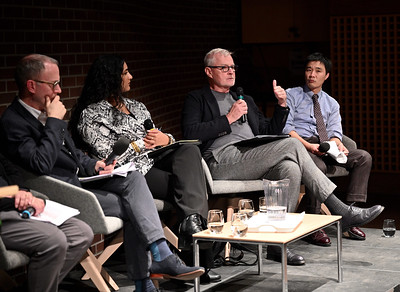
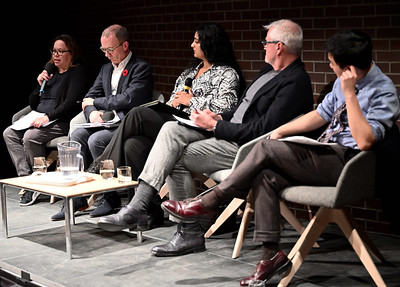
Several years ago, there were talks to get tax credits for the rehabilitation of historic buildings. Why did it fail? (33:45)
Robert answered that it failed because it was not well thought out – it was modeled after an initiative from the Nixon administration, which had been designed to incentivize people to restore historic buildings. From that, our Register and Standards and Guidelines were created, which are voluntary and not mandatory, and it is a grant and not a tax program. For example, $20 million over two years for the entire country meant around $1 million per province for a building a year, “which is absolutely ridiculous and guaranteed to fail”. However, Robert said that there was no real reason why it couldn’t be retried today.
Is a topic like tax credits for historic properties something indigenous people care about? (36:54)
Angie replied that she cared about tax credits – she explained that there were intersections of indigenous and mainstream interests in regard to heritage. Resourcing these intersections through innovative ways like tax credits are a good thing – when we talk about built heritage, we are talking about millions, and really, costs regarding built heritage are very high. She stated that there was also the need for other innovative ways to support other forms of heritage priorities that people have been identifying, and not focus on benefiting one type of heritage. Aneesha added that tax credits were useful in terms of what money can do, but their main concern was still the definition of heritage, which insinuates a form of ownership. They added that the city’s heritage register reflects a focus on settler heritage, which in turn reflects the heritage that is valued on this land.
Paul spoke about how heritage is defined in legislation – it uses the term ‘real property’, which is a legal term and rooted in the built environment. He added that he personally believed these definitions needed to change because it is not helpful in understanding a wider interpretation of heritage, but acknowledged the fact that the province had a tendency to stick to legislation to protect themselves. Robert added that the register is just one tool – having land on the register helps with connection to the land itself, but there are other tools that can speak to the heritage of the space. Adding to that, Paul mentioned a heritage program based on legislation that aimed to recognize some individuals, which went beyond the legalistic definition of ‘real property’.

Speaking about evolution, the broadening of heritage – such as the Historic Urban Landscape approach from UNESCO – is often seen as problematic. These new wide frameworks focus on climate change, intangible dimensions, economic values, and other issues. Is there a danger of broadening too much and losing focus? (44:24)
Robert stated that he didn’t think these ideas were new – even with areas like Robson Square and the Fairmont Academy building, planning went beyond the buildings. He said that a building and a site are never in isolation, and they are always related to somewhere else – there is a layering that city planners need to be aware of, especially when dealing with a new building in a historic context.
Angie added that it was necessary to see the diversity of heritage, and it was necessary to appreciate it. She stated that we don’t need to worry about losing focus, and we need to focus on creating space to consider different aspects of heritage and to teach members of the community about their ties to the land. There is more to think about in terms of land and buildings – there are intersections and connections with heritage that indigenous people have already focused on, such as climate change.
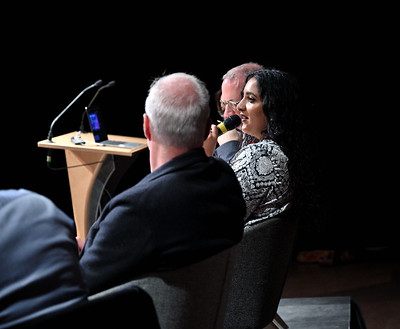
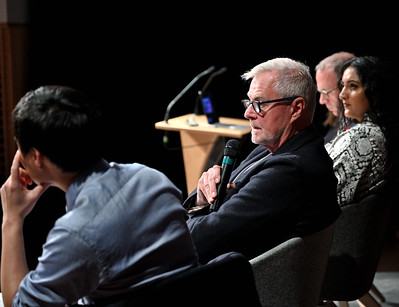
Angie, can you talk about your connection to 312 Main Street, which is a B listed heritage building? (49:14)
Angie explained that she worked with the UBCIC [Union of BC Indian Chiefs], who used to work in the Gastown area but outgrew their space and needed to find a new one. One of the places that caught their attention was 312 Main – the building was the former police station, and was where Frank Paul was incarcerated. Angie said that it was an interesting choice of location for them given the connotations of the space, but they liked the idea of 312 Main. When UBCIC first moved in, they wanted to reclaim the space, give it a new life, and change the feel of the building – UBCIC was the first tenant in the building. However, the office location has created some issues with Indigenous communities: just a half-floor above the office are jail cells, and it is uncomfortable for some to know that that’s there. Angie also noted that before they moved in, they had the building smudged over four or five times, and she acknowledged that the UBCIC knew that they were potentially taking up space from the Downtown Eastside community where some members had a different vision for that building.
There are some commonalities with the Fairmont Building on 33rd Ave, just off Cambie Street. It is an A listed heritage building, and the land is owned by the CLC and the MST Nations. A few years ago, the CLC and MST Nations requested that the building be removed as a sign of reconciliation, especially since it used to be an RCMP building. Council decided to have the building removed and have staff look at relocation. If it cannot be relocated, it will be demolished. (54:37)
Paul spoke about the need to find ways to come together and talk about issues like these. He stated that the Heritage BC watchlist was to raise awareness around issues and not to say that a building is threatened to be demolished. He said that there were ways to approach troubled buildings that did not need to mean demolition – he acknowledged that these conversations were highly challenging, but the processes was necessary and needed to be understood.
Robert spoke about an example in Hong Kong, where an assemblage of buildings from the colonial era were being reused for cultural and community use. He asked why the Fairmont Academy building couldn’t be viewed from “the same open eyes”. Robert spoke about his involvement with the planning exercises for the Fairmont property, which involved plotting the original settlement patterns, vegetation, geology and civil engineering. He also spoke about the history of the Fairmont building, stating that the problematic history mainly concerned its role in RCMP history, though it was also a boy’s school and a WWI hospital. He asked why there was not broader community engagement and suggested that the building could have been reused and repurposed for sustainability reasons as well, or considered “just a building” as it was perfectly usable and could be an asset for the land.
Aneesha added that this was a perfect example of what kind of heritage is valued – the building was a boy’s school, a medical hospital, and an RCMP headquarters. However, they stated that if the city was real about reconciliation efforts, the issue of the Fairmont building should be easy to solve.
Angie acknowledged the work of the City of Vancouver on reconciliation, adding that there were many indigenous members who had worked with the city to define reconciliation. However, she highlighted that the issue was that fields and disciplines become siloed, which makes it difficult to see how they intersect and apply to each other – heritage and reconciliation are not separate issues. Angie suggested that the city could build on the work they have done on reconciliation and expand it into heritage – the building blocks are there, the engagement and consultation done by the city on reconciliation was meaningful and involved communities, and relationships were being built. Angie concluded that for her, it was all about relationships, about people with competing values and ideas coming together and agreeing on what matters.
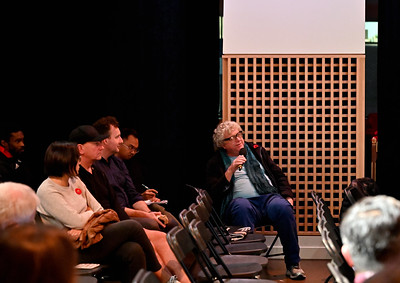
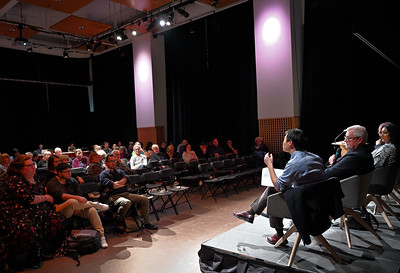
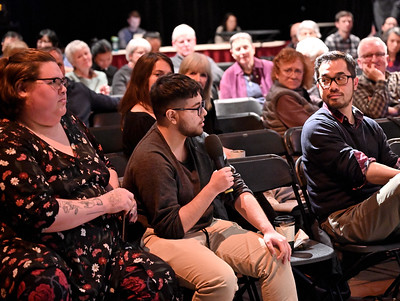
Questions and comments from the audience
There is an organizational problem in the city that makes moving to intangible heritage more difficult. The heritage commission deals with land and buildings, there is a park board that deals with cultural programming – the difficulty is that we are asking to sign up on commemoration efforts, rather than preservation or conservation. But the idea of rolling in ‘cultural heritage’ into the silos of cultural and physical planning…When I see cultural heritage programs coming forward, I don’t see how cultural history can be put into the design of new buildings. How do you see this coming together in the city? This is linked to the buildings, and land, and development. And that is being morphed into the definition of cultural heritage. (1:06:53)
Paul answered that heritage is often talked about as a single entity, when it is not. Paul stated he personal thought intersections were a good thing, and it wasn’t throwing one out and bringing in something new. It is necessary to evolve the conversation and ask: “What are the other values intrinsic with these buildings? How can we transform these buildings?”.
Robert added that the idea of commemoration and recognition beyond plaques are the obvious things. He said that there were ways to build into the urban fabric and link to how people interact with the land to bring silos together.
Comment on conundrums in the heritage community (1:13:39)
I think tonight is a good illustration of a conundrum in the heritage community. On one level, we want to respect associations with certain places, unless they are negative, in which case we don’t want to respect it. We want to argue for the positive associations and edit out the negatives. There is a demolition in the City of Burnaby; this is an Erick and Massey brutalist building, which was also a space where women had residence on the SFU campus as was supported by feminists to create a safe space. This building might be saved for its association with feminist history, but not for its architectural history.
I’m not a planner or architect. Could you [Angie] explain how funds for cultural heritage would be used? (1:17:34)
Angie answered that indigenous cultural heritage includes more than conventional understandings of heritage. For her community, heritage is living – it is not celebrating old buildings, old stories, and old documents. For indigenous heritage, heritage is only strong because it is living. The responsibilities are stewardship – for her, it is her responsibility to protect, educate, celebrate and pass down her heritage. It is part of who she is. Angie spoke a bit about her heritage – she is from a ranching community in Merritt, where they celebrate the coal mines and the ranchers. There are children in her community now relearning songs, learning about things that were recorded by ethnologists, relearning place names, learning about unique plants and medicines, working with the city to create an interpretive trail of the Canadian Pacific Railway… there are many things that can be done to recreate space, for the young and old. There just needs to be an opportunity to do so.
As an indigenous person, I ask why indigenous genocide is prioritised over indigenous heritage. Why are racist buildings or buildings associated with traumatic histories not taken down when communities are asking for them to be taken down, despite a different consensus at the federal or provincial levels? (1:22:36)
Robert asked why there couldn’t be both – a celebration and recognition of indigenous history in a way that is current and celebrated, but also involves repurposing a building. He brought of examples of German, American South, and Catholic Church buildings, which are used to remember difficult histories in a way that recognises the history but uses the buildings for other generations.
Aneesha disagreed, and said that it was impossible to celebrate both without creating a position of power and inferiority.
Angie added that when we look at buildings, we often have a narrow perspective. She mentioned the Charlie Lake Cave, one of the oldest habitation sites known in northern BC, and asked why some habitations are considered more valuable. Heritage is more than what we see in the city – there are longstanding and multigenerational communities that exist outside cities.
Comment on the importance of stories (1:28:20)
I’m an architect and living in False Creek South. Listening to the words ‘stories’ and ‘relationships’ have resonance with me, as a designer. These stories are the matrix that we draw from for ‘doing stuff’. Without them, you lose the matrix to design meaningful things.
Angie spoke eloquently on the importance and dignity of preserving your culture. I feel the same way, but my story and culture are viewed a bit differently. I want to respect my ancestors and my history as well, and every time I see an old building come down, I feel more lost. (1:30:45)
Angie agreed, but mentioned that there has not been space created yet for the other side of the story. No one would know the histories if there is no space. Aneesha added that it is time for a sense of urgency to be for the other communities.
Comment on the definition of heritage in Vancouver (1:33:52)
As a person of colour and settler with a complicated history of colonization, I feel that wanting to preserve monuments and buildings tied to genocide is racist. A lot of people have died with the building of this city. We need to reconsider what heritage means and whose heritage matters.
Comment on heritage and colonial violence (1:34:44)
I want to focus on the question: what’s the use of heritage? I wanted to comment on Robert’s examples of Hong Kong and Singapore. For the Hong Kong projects, the colonial violence has not been addressed – there is the use of art-washing but it has not really addressed the colonial violence. How can we use the architecture – the colonial architecture in Hong Kong – to address the colonial violence that had taken place? Perhaps fracturing it physically to inscribe violence into the colonial violence? How can we use heritage against heritage itself?
Robert: What alternative would you suggest? (1:35:54)
Singapore uses art-washing to efface colonial violence as well. It is centered around the notion of using heritage against heritage – but it preserves buildings without celebrating the glory of the British Empire.
Robert: Is that how you view the project in Hong Kong? (1:37:00)
Yes.
Speaking about relationships, I think it is admirable that Heritage BC has been able to get an indigenous person on their board [Angie]. How did you build this relationship and how do you sustain it? (1:37:31).
Paul answered that Heritage BC had been grappling with this issue for awhile. They felt that they needed to change the conversation, bringing in voices that had not been included in the past. But they realized that they needed to embody this themselves and thought it was important to have a diversity of voices on the board to guide conversations. Paul added that often we do things ‘because it’s the right thing to do’, but Heritage BC was determined not to do that in this case.
Angie said that for her, this type of heritage was not something she understood – her first concern was how she would be effective and bring in her community’s perspectives. She said she was lucky to work there at such a level, and work in her community, and work in other communities. Angie described them as ways and opportunities to learn and give back without being just another token person on the committee. She said she was glad to have joined Heritage BC and felt that she made the right decision.
Aneesha added that she felt it was a bit worrying that in the history of Heritage BC, there had only been the inclusion of an indigenous person in the past few years – she said that this deserved more questions, but just a clap. Paul responded that this was a big change and that Heritage BC is going through an evolutionary process and they are trying to include more indigenous people. It has to start somewhere, and it has to start with a first step – Heritage BC is in the first step.
Angie also added that one of the things that she likes in her work is that she gets asked “why is your heritage more important than our heritage?”, and she gets to share the things that are more important to her. Another question she gets asked is “how do we do more engagement?”, which becomes an opportunity for her to teach.
We acknowledge the financial assistance of the Province of British Columbia. Thank you to SFU’s Vancity Office of Community Engagement for co-presenting the series.
All photo credits go to roaming-the-planet.